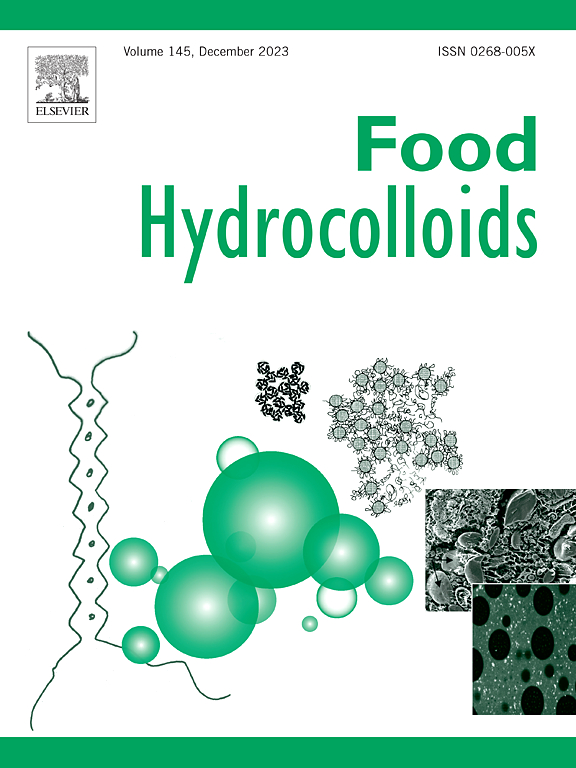A pH responsive fluorescent/visible light-emitting film for real time visual monitoring of food freshness
IF 11
1区 农林科学
Q1 CHEMISTRY, APPLIED
引用次数: 0
Abstract
A dual-layer pH-responsive fluorescent film was developed using hydroxypropyl methylcellulose (HPMC), zinc alginate (ZA), fluorescein isothiocyanate (FITC), and dragon fruit peel extract (DE) for real-time food freshness monitoring. The outer protective layer served as a hydrophobic barrier to reduce moisture interference, while the inner indicator layer acted as a pH-sensitive interface, integrating FITC's fluorescence and DE's visible color change for dual-mode sensing. The film exhibited good thermal stability, antimicrobial activity, and improved hydrophobicity. Optical responses were evaluated across a wide pH range (2.0–12.0), showing stable visible color under ambient light and enhanced fluorescence under 365 nm UV. Upon exposure to ammonia vapor, fluorescence intensity increased linearly from 0 to 1000 ppm (R2 = 0.9895; LOD = 6.73 ppm), while visible color changes became evident at 500–5000 ppm, with R/B and R/G ratios exhibiting strong linearity (R2 = 0.96176 and 0.96747; LODs = 1126 ppm and 958 ppm, respectively). Application trials with pork revealed distinct color changes after 4 days at 25 °C or 2 days at 5 °C. These results confirm the film's effectiveness for dual-mode, non-destructive, and real-time monitoring of pork freshness.

一种pH值响应荧光/可见光薄膜,用于食品新鲜度的实时视觉监测
采用羟丙基甲基纤维素(HPMC)、海藻酸锌(ZA)、异硫氰酸荧光素(FITC)和火龙果皮提取物(DE)制备了一种双层ph响应荧光膜,用于食品新鲜度实时监测。外层保护层作为疏水屏障,减少水分干扰,内层指示层作为ph敏感界面,整合FITC的荧光和DE的可见色变化,实现双模传感。该膜具有良好的热稳定性、抗菌活性和疏水性。在较宽的pH范围内(2.0-12.0)评估光学响应,在环境光下显示稳定的可见颜色,在365 nm紫外下荧光增强。暴露于氨蒸汽后,荧光强度从0 ~ 1000 ppm呈线性增加(R2 = 0.9895;LOD = 6.73 ppm),而在500-5000 ppm时,可见颜色变化明显,R/B和R/G比表现出很强的线性关系(R2 = 0.96176和0.96747;lod分别为1126 ppm和958 ppm)。猪肉的应用试验显示,在25°C或5°C条件下放置4天或2天后,颜色发生明显变化。这些结果证实了薄膜对猪肉新鲜度的双模式、非破坏性和实时监测的有效性。
本文章由计算机程序翻译,如有差异,请以英文原文为准。
求助全文
约1分钟内获得全文
求助全文
来源期刊

Food Hydrocolloids
工程技术-食品科技
CiteScore
19.90
自引率
14.00%
发文量
871
审稿时长
37 days
期刊介绍:
Food Hydrocolloids publishes original and innovative research focused on the characterization, functional properties, and applications of hydrocolloid materials used in food products. These hydrocolloids, defined as polysaccharides and proteins of commercial importance, are added to control aspects such as texture, stability, rheology, and sensory properties. The research's primary emphasis should be on the hydrocolloids themselves, with thorough descriptions of their source, nature, and physicochemical characteristics. Manuscripts are expected to clearly outline specific aims and objectives, include a fundamental discussion of research findings at the molecular level, and address the significance of the results. Studies on hydrocolloids in complex formulations should concentrate on their overall properties and mechanisms of action, while simple formulation development studies may not be considered for publication.
The main areas of interest are:
-Chemical and physicochemical characterisation
Thermal properties including glass transitions and conformational changes-
Rheological properties including viscosity, viscoelastic properties and gelation behaviour-
The influence on organoleptic properties-
Interfacial properties including stabilisation of dispersions, emulsions and foams-
Film forming properties with application to edible films and active packaging-
Encapsulation and controlled release of active compounds-
The influence on health including their role as dietary fibre-
Manipulation of hydrocolloid structure and functionality through chemical, biochemical and physical processes-
New hydrocolloids and hydrocolloid sources of commercial potential.
The Journal also publishes Review articles that provide an overview of the latest developments in topics of specific interest to researchers in this field of activity.
 求助内容:
求助内容: 应助结果提醒方式:
应助结果提醒方式:


